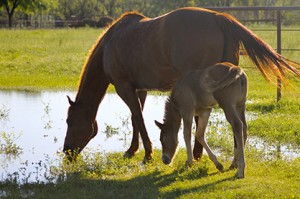Disaster Preparedness For Horse Owners

“Different types of disasters call for different responses, from evacuating your horses to keeping them safe in a barn or in a field.” Photo Credit: Brittany Bevis
September is National Preparedness Month, so it is a good time for horse owners to make sure their horses are included in disaster plans. The key to remaining calm and keeping your animals safe during an emergency is being prepared. Natural disasters can strike anywhere at any time, and pet owners have the responsibility of including their animals in their emergency plan. When planning for pets includes horses, it requires even more consideration.
Cindy Gendron, coordinator for The Homes for Horses Coalition, said: “Different types of disasters call for different responses, from evacuating your horses to keeping them safe in a barn or in a field. Once you understand your options, the next steps are developing a plan, organizing your resources and practicing and training for possible scenarios. If a disaster does strike, you’ll be ready to protect yourself and your horse.” The ASPCA’s Top 10 Disaster Readiness Tips for Horses can help you protect your horses from both natural disasters and ordinary accidents. In addition, The HSUS offers the following considerations.
Planning for a disaster
- Permanently identify each horse by tattoo, microchip, brand, or photograph. In your records, include the horse’s age, sex, breed, and color. Keep this information with your important papers.
- Keep halters ready for your horses. On each halter attach a luggage tag with the following information: the horse’s name, your name, email address, your telephone number, and another emergency telephone number where someone can be reached. At the time of evacuation, consider additional temporary identification such as a leg band.
- Place your horses’ Coggins tests, veterinary papers, identification photographs, and vital information—such as medical history, allergies, and emergency telephone numbers (veterinarian, family members, etc.)—in a watertight envelope. Store the envelope with your other important papers in a safe place that will be easy for you to access, so you can take them with you when you and your horses evacuate.
- Prepare a basic first aid kit that is portable and easily accessible.
- Be sure to include enough water (12 to 20 gallons per day per horse), hay, feed, and medications for several days for each horse.
- Make arrangements in advance to have your horse trailered in case of an emergency. If you don’t have your own trailer or don’t have enough room in your trailer for all of your horses, be sure you have several people on standby to help evacuate your horses.
Evacuation
- It is important that your horses are comfortable being loaded onto a trailer. If your horses are unaccustomed to being loaded onto a trailer, practice the procedure today so they become used to it if or when an emergency strikes.
- Know where you can take your horses in an emergency evacuation. When possible, make arrangements with a friend or another horse owner to stable your horses well beyond the region at risk.
- Contact your local animal care and control agency, agricultural extension agent, or local emergency management authorities for information about shelters in your area.
If you cannot evacuate with your horse
- Have a back-up plan in case it’s impossible to take your horse with you when you evacuate. Consider different types of disasters and whether your horses would be better off in a barn or loose in a field. Your local humane organization, agricultural extension agent, or local emergency management agency may be able to provide you with information about your community’s disaster response plans.
- Share your evacuation plans with friends and neighbors. Post detailed instructions in several places—including the barn office or tack room, the horse trailer, and barn entrances—to ensure emergency workers can see them in case you are not able to evacuate your horses yourself.
Additional planning is required when moving the following: exceptionally young, exceptionally old or mobility-impaired equines, stallions, especially high strung horses, or a large number of horses. Being located far from a main road is an added complication to factor into your plan.










